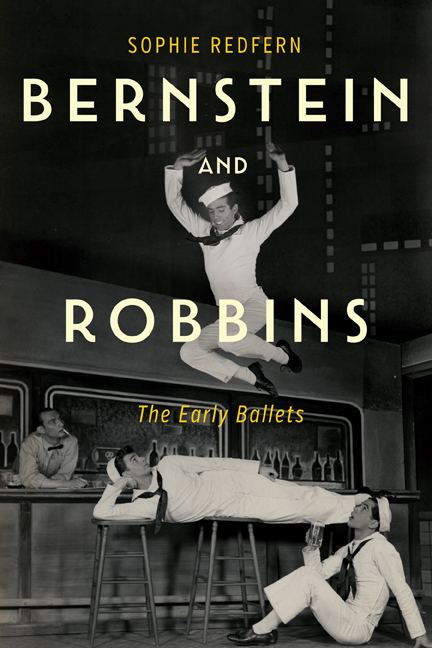Book contents
- Frontmatter
- Dedication
- Contents
- List of Illustrations
- Acknowledgments
- List of Abbreviations
- Editorial Note
- Preface
- 1 Setting the Scene: American Ballet and Jerome Robbins
- 2 Toward a First Ballet: Fancy Free Takes Shape
- 3 Creating Fancy Free: A Long-Distance Collaboration
- 4 The Music of Fancy Free: The Sketches and Score Explored
- 5 The Fancy Free Premiere and a Move to Broadway
- 6 Toward a Second Ballet: Bye Bye Jackie and the Creation of Facsimile
- 7 The Music of Facsimile: The Sketches and Score Explored
- 8 The Facsimile Premiere and Legacy of the Ballets
- Epilogue: Bernstein and Dance
- Bibliography
- Index
5 - The Fancy Free Premiere and a Move to Broadway
Published online by Cambridge University Press: 23 March 2021
- Frontmatter
- Dedication
- Contents
- List of Illustrations
- Acknowledgments
- List of Abbreviations
- Editorial Note
- Preface
- 1 Setting the Scene: American Ballet and Jerome Robbins
- 2 Toward a First Ballet: Fancy Free Takes Shape
- 3 Creating Fancy Free: A Long-Distance Collaboration
- 4 The Music of Fancy Free: The Sketches and Score Explored
- 5 The Fancy Free Premiere and a Move to Broadway
- 6 Toward a Second Ballet: Bye Bye Jackie and the Creation of Facsimile
- 7 The Music of Facsimile: The Sketches and Score Explored
- 8 The Facsimile Premiere and Legacy of the Ballets
- Epilogue: Bernstein and Dance
- Bibliography
- Index
Summary
Advance Publicity
Ballet Theatre's spring season at the Metropolitan Opera House began on April 9, 1944, the same night rival company the Ballet Russe de Monte Carlo opened at City Center. The New York Times ran the headline “Battle of the Ballets” to mark the competition between what it described as the “two leading contenders for the heavyweight ballet championship of America.” With audience loyalty potentially divided, Ballet Theatre's marketing focused on what it considered set it apart: according to the advertisements, Ballet Theatre offered the best of Russian ballet. In the run up to the season, all the advertisements focused on this, a prime example being a full-page spread in the program for two Carnegie Hall concerts given by the Philharmonic-Symphony Society of New York conducted by Bernstein on March 29 and 31 (fig. 5.1).
Ballet Theatre may have claimed to be international in scope, with its American and English wings, but the company largely stuck to a populist and traditional image of ballet to sell seats. As the advertisement shows, going into the 1944 season, Ballet Theatre was proudly declaring it presented “RUSSIAN BALLET,” and in case of any confusion, the image of a ballerina on pointe in a classical tutu reinforced the message. This was an advertisement primarily selling the comfort and reassurance of Tchaikovsky and Petipa, of Swan Lake and Sleeping Beauty. The message was clear: to see “authentic” Russian ballet at the Metropolitan Opera House, i.e. the most glamorous setting in New York, come see Ballet Theatre.
And yet, the three new ballets being presented, none of which were by Russian artists, on Russian subjects, or in the classical style, are also heralded. Ballet Theatre was striving to assert its status as a company that continued to create new works and push forward exciting new productions even if this mostly appealed to aficionados. Top billing of the three commissions was given to Agnes de Mille's Tally-Ho. De Mille had achieved considerable success in ballet and on Broadway by this stage (the previous year she had choreographed Rodgers and Hammerstein's Oklahoma! and Weill's One Touch of Venus) and so was certainly the most well-known choreographer of the trio. Hopes would have been high for her work, but Fancy Free was also listed, as was El amor Brujo by Spanish artist La Argentinita.
- Type
- Chapter
- Information
- Bernstein and RobbinsThe Early Ballets, pp. 151 - 175Publisher: Boydell & BrewerPrint publication year: 2021



